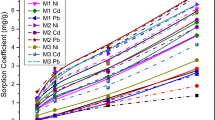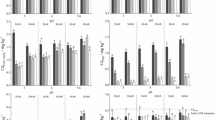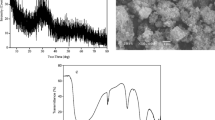Abstract
Soil contamination by heavy metals is a worldwide environmental challenging issue. Due to the industrial activities, a site located in North West of Shiraz (Fars Province, Iran) has the potential to be contaminated by different heavy metals. The objective of this study was to assess the effectiveness of dicalcium phosphate (DCP) and sodium tripolyphosphate (STPP) for immobilizing lead, copper and cadmium in contaminated soils. Leaching column tests performed on the soil without any stabilizing agent demonstrated a uniform leachate of metals in the effluent during the experimental period. After mixing DCP or STTP with the contaminated soils, the release of all three heavy metals through the effluent was ceased. The results further indicated that 0.1–0.2 % by weight of these stabilizers is effective for immobilizing of applied metals through the experimental soil. Penetration of sulfuric acid solution with pH of 5 had no influence on stabilizing efficiency and almost completely the applied heavy metals seem to be immobilized through the soil media.












Similar content being viewed by others
References
Ahmad MS, Shah SS (2010) Load bearing strength of fly ash modified with cement and waste sludge. Int J Civ Eng 8(4):315–326
Harichane K, Ghrici M, Kenai S (2011) Effect of curing time on shear strength of cohesive soils stabilized with combination of lime and natural pozzolana. Int J Civ Eng 9(2):90–96
Wei-Hong W, Zheng-Miao X, Jian-Ming X, Fan W, Jia-Chun S, Rong-Bin Z, Zan-Fang J (2013) Immobilization of trace metals by phosphates in contaminated soil near lead/zinc mine tailings evaluated by sequential extraction and TCLP. J Soils Sediments 13:1386–1395
Mignardi S, Corami A, Ferrini V (2013) Immobilization of Co and Ni in mining-impacted soils using phosphate amendments. Water Air Soil Pollut 224:1447
Ping T, Yong-chao Z, Zhen-miao X (2013) Immobilization of heavy metals in sludge using phosphoric acid and monobasic calcium phosphate. J Zhejiang Univ Sci A 14(3):177–186
Mignardi S, Corami A, Ferrini V (2012) Evaluation of the effectiveness of phosphate treatment for the remediation of mine waste soils contaminated with Cd, Cu, Pb, and Zn. Chemosphere 86:354–360
Cotter-Howells J (1996) Lead phosphate formation in soils. Environ Pollut 93:9–16
Hettiarachchi GM, Pierzynski GM, Ransom MD (2000) In situ stabilization of soil sead using phosphorous and manganese oxide. Environ Sci Technol 34:4614–4619
Ma QY, Traina SJ, Logan TJ, Ryan JA (1994) Effects of aqueous Al, Cd, Cu, Fe(II), Ni and Zn on Pb immobilization by hydroxyapatite. Environ Sci Technol 28:1219–1228
Ryan JA, Zhang P, Hesterberg D, Chou J, Sayers DE (2001) Formation of chloropyromorphite in a lead-contaminated soil amended with hydroxyapatite. Environ Sci Technol 35:3798–3803
Falamaki A, Shariatmadari N, Noorzad A (2008) Strength properties of hexametaphosphate treated soils. ASCE J Geotech Geoenviron Eng 134(8):1215–1218
Spance RD, Shi C (2005) Stabilization and solidification of hazardous, radioactive and mixed wastes, 1st edn. CRC Press, Boca Raton
Bostick WD, Stevenson RJ, Jarabek RJ, Conca JL (1999) Use of apatite and bone char for the removal of soluble radionuclides in authentic and simulated DOE groundwater. Adv Environ Res 3(4):488–498
Rakovan J, Reeder RJ, Elzinga EJ, Cherniak DJ, Tait CD, Morris DE (2002) Structural characterization of U (VI) in apatite by X-ray absorption spectroscopy. Environ Sci Technol 6(14):3114–3117
Theodoratos P, Papassiopi N, Xenidis (2002) Evaluation of monobasic calcium phosphate for the immobilization of heavy metals in contaminated soils from Lavrion. J Hazard Mater 94:135–146
Deydier E, Guilet R, Sharrock P (2003) Beneficial use of meat and bone meal combustion residue: ‘an efficient low cost material to remove lead from aqueous effluent’. J Hazard Mater 101(1):55–64
Fuller CC, Bargar JR, Davis JA (2003) Molecular-scale characterization of uranium by bone apatite materials for a permeable reactive barrier demonstration. Environ Sci Technol 37:4642–4649
Thomson BM, Smith CL, Busch RD, Siegel MD, Baldwin C (2003) Removal of metals and radionuclides using apatite and other natural sorbents. J Environ Eng 129(6):492–499
Marchat D, Bernache-Assollant D, Champion E (2007) Cadmium fixation by synthetic hydroxyapatite in aqueous solution—thermal behaviour. J Hazard Mater 139:453–460
Corami A, Mignardi S, Ferrini V (2008) Removal of lead, copper, zinc and cadmium from water using phosphate rock. Acta Geol Sin Eng 82:1223–1228
Hashimoto Y, Taki T, Sato T (2009) Sorption of dissolved lead from shooting range soils using hydroxyapatite amendments synthesized from industrial byproducts as affected by varying pH conditions. J Environ Manag 90:1782–1789
Cao X, Wahb A, Ma L, Li B, Yang Y (2009) Immobilization of Zn, Cu, and Pb in contaminated soils using phosphate rock and phosphoric acid. J Hazard Mater 164:555–564
Chen Sh, Xu M, Ma Y, Yang J (2007) Evaluation of different phosphate amendments on availability of metals in contaminated soil. Ecotoxicol Environ Saf 67:278–285
Islam M, Mishra PC, Patel R (2010) Physicochemical characterization of hydroxyapatite and its application towards removal of nitrate from water. J Environ Manag 91:1883–1891
Melamed R, Cao X, Chen M, Ma LQ (2003) Field assessment of lead immobilization in a contaminated soil after phosphate application. Sci Total Environ 305:117–127
Chen J, Wang Y, Zhou D, Cui Y, Wang S, Chen Y (2009) Adsorption and desorption of Cu (II), Zn (II), Pb(II), and Cu (II) on the soils amended with nanoscale hydroxyapatite. Environ Prog Sustain Energy 29:233–241
Chen SB, Zhu YG, Ma YB (2006) The effect of grain size of rock phosphate amendment on metal immobilization in contaminated soils. J Hazard Mater 13:474–479
Miretzky P, Fernandez-Cirelli A (2008) Phosphates for Pb immobilization in soils: a review. Environ Chem 6:121–133
Thawornchaisit U, Polprasert C (2009) Evaluation of phosphate fertilizers for the stabilization of cadmium in highly contaminated soils. J Hazard Mater 165:1109–1113
Song Y, Sivakumar Ch, Nguyen S, Kim T, Kim SB (2009) The immobilization of heavy metals in biosolids using phosphate amendments—comparison of EPA (6010 and 3051) and selective sequential extraction methods. J Hazard Mater 167:1033–1037
Tavallali H, Falamaki A, Salehi H (2010) Stabilization of metal contaminants in municipal waste leachate using metal precipitant additives. J Chem Tech 2(3):1753–1760
Park JH, Bolan N, Megharaj M, Naidu R (2011) Comparative value of phosphate sources on the immobilization of lead, and leaching of lead and phosphorus in lead contaminated soils. Sci Total Environ 409:853–860
Author information
Authors and Affiliations
Corresponding author
Rights and permissions
About this article
Cite this article
Falamaki, A., Tavallali, H., Eskandari, M. et al. Immobilizing Some Heavy Metals by Mixing Contaminated Soils With Phosphate Admixtures. Int. J. Civ. Eng. 14, 75–81 (2016). https://doi.org/10.1007/s40999-016-0006-5
Received:
Revised:
Accepted:
Published:
Issue Date:
DOI: https://doi.org/10.1007/s40999-016-0006-5




